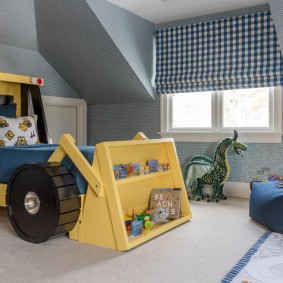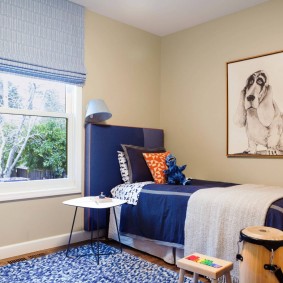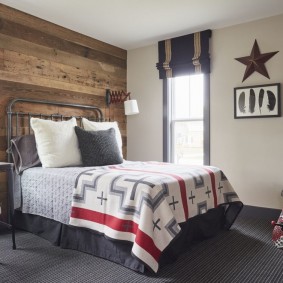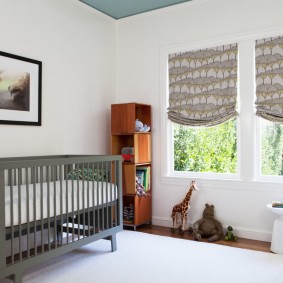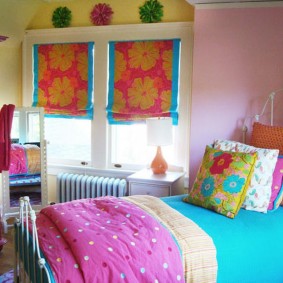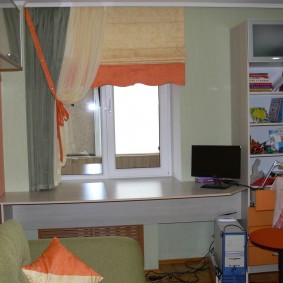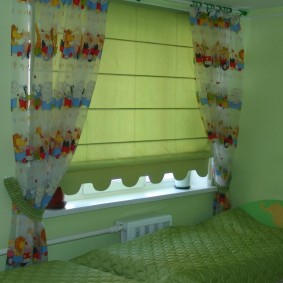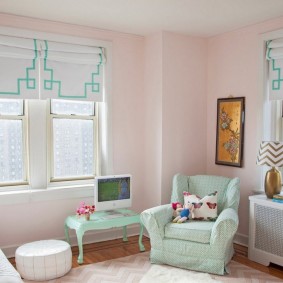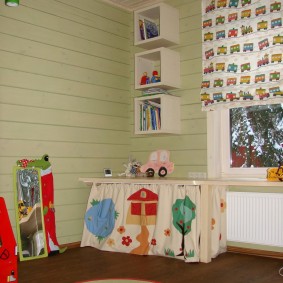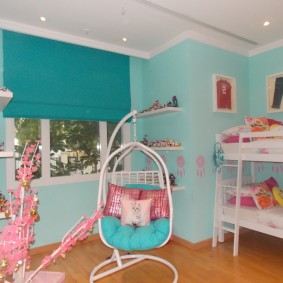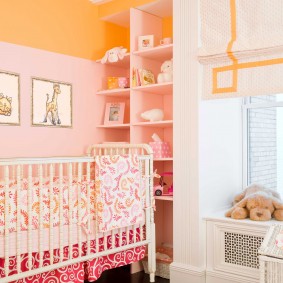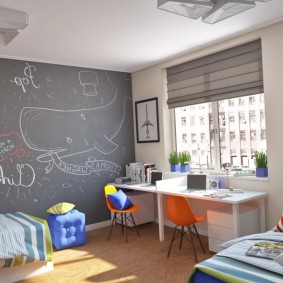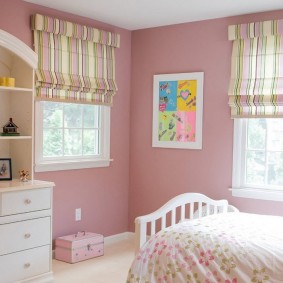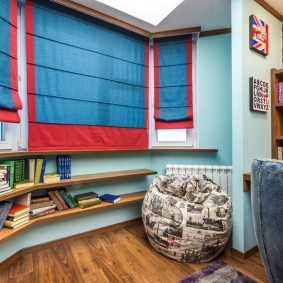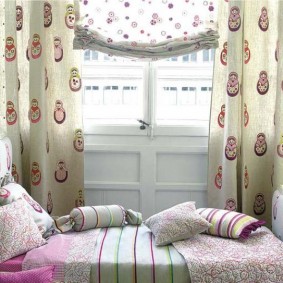 Children
DIY room decor for a teenage girl. Where to start the change?
Children
DIY room decor for a teenage girl. Where to start the change?
You want to add an original twist to the interior, and at the same time prefer comfort in everything. Then you should pay attention to the Roman curtains. Moreover, if you pick up the curtains in the nursery, romance ones will be a great option, since not every teenager is able to close regular curtains evenly without breaking them or messing them up.

Roman curtains will be the best solution for the room of a boy or girl, regardless of the size of the room and the style of the interior
Hanging Roman curtains in the nursery is a great solution, they are lowered by a chain, do not reach the floor, it is very convenient when cleaning, and do not require scrupulous care.
Features of Roman curtains in the interior of a children's room
Content
- Features of Roman curtains in the interior of a children's room
- Curtain materials
- Choosing a color palette for Roman curtains
- The choice of curtains depending on the age of the child
- Decoration options for Roman curtains
- Photos of the design of a children's room with Roman curtains
- Video: Roman curtains in the interior of a children's room
- Photo-ideas for decorating windows in children's rooms
Since they were invented, even in ancient Rome, the design of Romanesque curtains has not undergone major changes. They were used to protect houses from dust and scorching sunlight.

When raised, the Roman curtain forms neat folds, and its design allows you to adjust the amount of natural light in the room
Design:
- An aluminum profile is necessary to protect the mechanism that raises the canvas.
- Pulling mechanism.
- Lifting mechanism.
- Double tape. It holds the curtain material and, if necessary, can easily remove the curtains from the curtain rod.
- Plumb line. A kind of weighting agent that gives the canvas rigidity and preserves its shape.
- Mounting to the cornice.

The device of the Roman curtains
Roman curtains will add a stylish accent and comfort to the interior of the children's room. Parents who adhere to the Scandinavian style or art deco style when arranging the children's room, especially should pay special attention to this kind of curtains.
Curtains can close one window, but have several parts. If necessary, an excellent opportunity will be available to lift only one part of the curtains, for example, to ventilate. It is also convenient in bright sunlight, you can leave closed those parts of the curtain on which the bright rays of the sun directly fall, and open the rest. In this case, excessive insolation is not scary for you.

Roman curtains can be chosen for any style of interior
Advantages of Roman curtains in a children's room:
- The best option for allergy sufferers. A minimum amount of dust is collected on this type of curtains, which can negatively affect children in principle, and even more so for allergy sufferers. And then a small amount of settling dust is easily eliminated by washing. To remove material from the eaves will take no more than one minute.
- Many manufacturers treat curtains with a hypoallergenic solution that prevents dust from settling on the canvas. Basically, German manufacturers are famous for this approach.
- Security. Children, both boys and girls, are often very energetic, and without noticing a long curtain, they can accidentally get entangled in it, slip, cling to the curtains and ruin the ledge on themselves. In other words, standard curtains are rather traumatic, which cannot be said about Roman ones.Their length, as a rule, reaches the windowsill. For children, they are completely inaccessible.
- Illumination. The throughput of Romanesque curtains is optimal both for daylight and for the penetration of electricity by light in the dark. When opening the curtains, the room is lit as much as possible, since the curtains absolutely do not obscure the window. And at any time you can edit the illumination of the room, raising or lowering the curtains to the required height.
- Practicality. The canvas of the Romanesque curtains do not require a lot of fabric. They are distinguished by simplicity and conciseness. They are very easy to remove, wash and dry. Children often, not paying attention to the cleanliness of their hands, grab onto the curtains, so on the classic curtains you can easily find traces of jam, plasticine, paints, chocolate, as well as greasy traces. If, after frequent washing, the canvas loses its color quality, then buying new ones will not hit your pocket at all. For active children and teenagers, Roman curtains in the nursery
Is the best idea. - Aesthetics. Psychologists recommend making the child’s room saturated with bright colors, which has a very positive effect on the child’s perception of the world and its psychological development.
Curtain materials
Roman curtains in the nursery should be chosen wisely, since the curtains should not let in a lot of light in the daytime, and completely block the light during sleep. Synthetic fabrics with a minimum light transmission threshold are best suited for such cases. Curtains made of vinyl, satin, jacquard, blackout, etc. also perfectly block light.
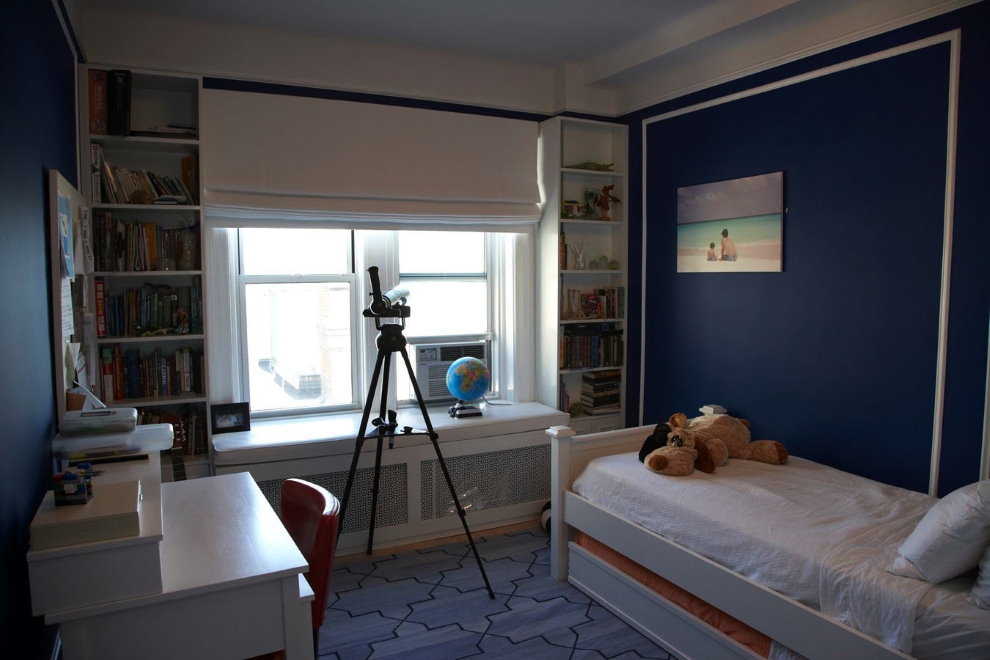
For a sunny room, a Roman blind made of thick blackout material will be a great option

Depending on the choice of fabric curtains care for it will be different
Natural materials
Most people, choosing curtains, especially to a nursery, do not have to think, resort to choosing natural fabrics, focusing on the fact that they are natural, without going into details, which actually have such pros and cons.

Curtains made of natural fabrics are primarily recommended for window decoration in rooms for small children.
View the most popular ones in more detail.
Cotton fabric
Cotton is characterized by excellent light transmission, but it is extremely difficult to keep its appearance even and smooth, so cotton is often used with synthetics added to the fabric. Thus, the appearance of a cotton curtain looks much more attractive.

Cotton Roman curtains in a marine style room for a school-aged boy
Pros:
- naturalness of the material;
- budgeting;
- color saturation;
- softness.
Minuses:
- quickly loses the brightness of colors under the influence of the sun;
- after washing, it slightly decreases in size;
- hesitates very much.
Linen fabric
Most often, unpainted linen is used as curtains. It’s just that not every parent wants to hang a decent, but still a little boring light gray smooth linen in the room of his beloved child.

Floral curtains in a Provencal style room
Pros:
- naturalness of the material;
- durability;
- retains its original appearance;
Minuses:
- hesitates very much;
- lack of form.
Blended fabrics
A mixture of natural and synthetic fabrics creates an excellent tandem, combining all the advantages of both types of materials.

Elegant Scandinavian-style mixed-fabric curtain on the window of a room
Pros:
- a large selection of light transmission;
- hardly wrinkle;
- do not change in size during operation.
Minuses:
- are electrified;
- form spools.
Dense materials: Synthetic fabrics
Synthetic fabrics are considered the best in their light transmission. This is the most popular material for sewing curtains.

Laconic curtains made of synthetic plain fabric in a modern style children's room
Pros:
- has a wide variety of colors and decor;
- repels dust;
- perfectly blocks sunlight;
- such curtains can be washed quite rarely.
Minuses:
- fire hazard;
- can deteriorate under the influence of sunlight, melt and deform;
- When ignited, toxic substances are released.
Choosing a color palette for Roman curtains
When choosing a color palette, many factors must be considered. The style and color scheme will be directly affected by whose room it is, a girl or a boy, a small child or a teenager. Is the room adequately lit or on the shady side.

For a spacious room in pastel colors, you can choose bright curtains

For a room of a small size or with insufficient natural light, it is better to choose light fabrics
When choosing a color, try not to focus on pink and blue tones. Psychologists recommend not succumb to stereotypes.
For a girl, it’s better to pick out gentle, pastel tones of any shades, not necessarily pale pink or pale purple, there are examples of excellent rooms for girls in pastel green tones, as well as soft blue and peach shades.

In the room for the girl, most often choose curtains with floral or other unpretentious drawings.
All the listed colors of curtains are also suitable for boys, and catchy color solutions, as well as all kinds of prints, should not be excluded.

Boys usually like blue, brown or gray shades.
The choice of curtains depending on the age of the child
The choice of colors depends on the age of the child. Preschool children need many colors to stimulate the thought process. But on young schoolchildren, on the contrary, the variety of bright colors affects rather negatively, stimulating their psyche, contribute to restless sleep. Let's consider in more detail.

Properly selected curtain is an indicator of the true taste of style
Roman curtains for the newborn
The rooms of newborns are most often decorated in bright and natural colors. The room should be soothing, so the curtains are selected in pastel colors so that the little child does not interfere with falling asleep and enjoying sleep.

For a room with a newborn, the best solution would be double Roman curtains, consisting of two canvases - translucent tulle and dense opaque material
Children from 3 to 11 years old are recommended colored curtains, using various colors and prints, but in no case are not very bright. Choose intricate multi-colored prints on the curtains, so that falling asleep and waking up, the child could carefully consider them.

Geometric prints add originality and make the interior more interesting.
For a schoolboy
Students over 12 years old can without hesitation choose the most vivid and contrasting shades. Bright curtains will favorably influence the activity of the child, the development of his imagination, and your child will really like the room that is in perfect harmony with the bright curtains.

Bright yellow curtain with white garters in the room of a school-age girl
For teenager
Modern teens prefer rooms decorated in a particular style. More often it is a room of pastel colors with a bright accent. Therefore, you can stop the choice both on the curtains of soothing tones, and in bright contrast with the basic color scheme of the room.

For a teenage boy, it's better to choose classic plain options
Decoration options for Roman curtains
As a design solution, you can perfectly combine both curtains and Roman curtains. Such options look original and very functional.

A harmonious combination of a plain Roman curtain with a striped curtain
If you want to add airiness and lightness to the nursery, use the option of combining plain Romanesque curtains, over which transparent and delicate tulle will flow in the same tone.

The combination of Roman curtains with tulle looks very dignified and organically
The same combination of Romanesque curtains, but more dense tulle will look extravagant. The effect will be completely different, not so airy, but equally original. The combination of matte textures in a classic style will add a touch of elegance to the interior, and flashy bright plain matte curtains will create a positive, youthful and energetic atmosphere.
Photos of the design of a children's room with Roman curtains
If the child is a schoolboy, talk to him in advance, discuss which colors are pleasant to him and which evoke negative emotions. Ask if he wants to see images of his favorite cartoon characters in the room or if he would like to have a plain look of his favorite corner. Also with a teenager, it is important to consider the opinion of the child. This is his room, and he will spend more time in it. Try to combine your knowledge and preferences and wishes of the child himself.

Canvases decorated with fringe, bows, ribbons or other decor look much more attractive.

A competent color scheme is responsible for the emotional comfort of your child

The original design of the children's room helps create Roman curtains with photo printing
Video: Roman curtains in the interior of a children's room


